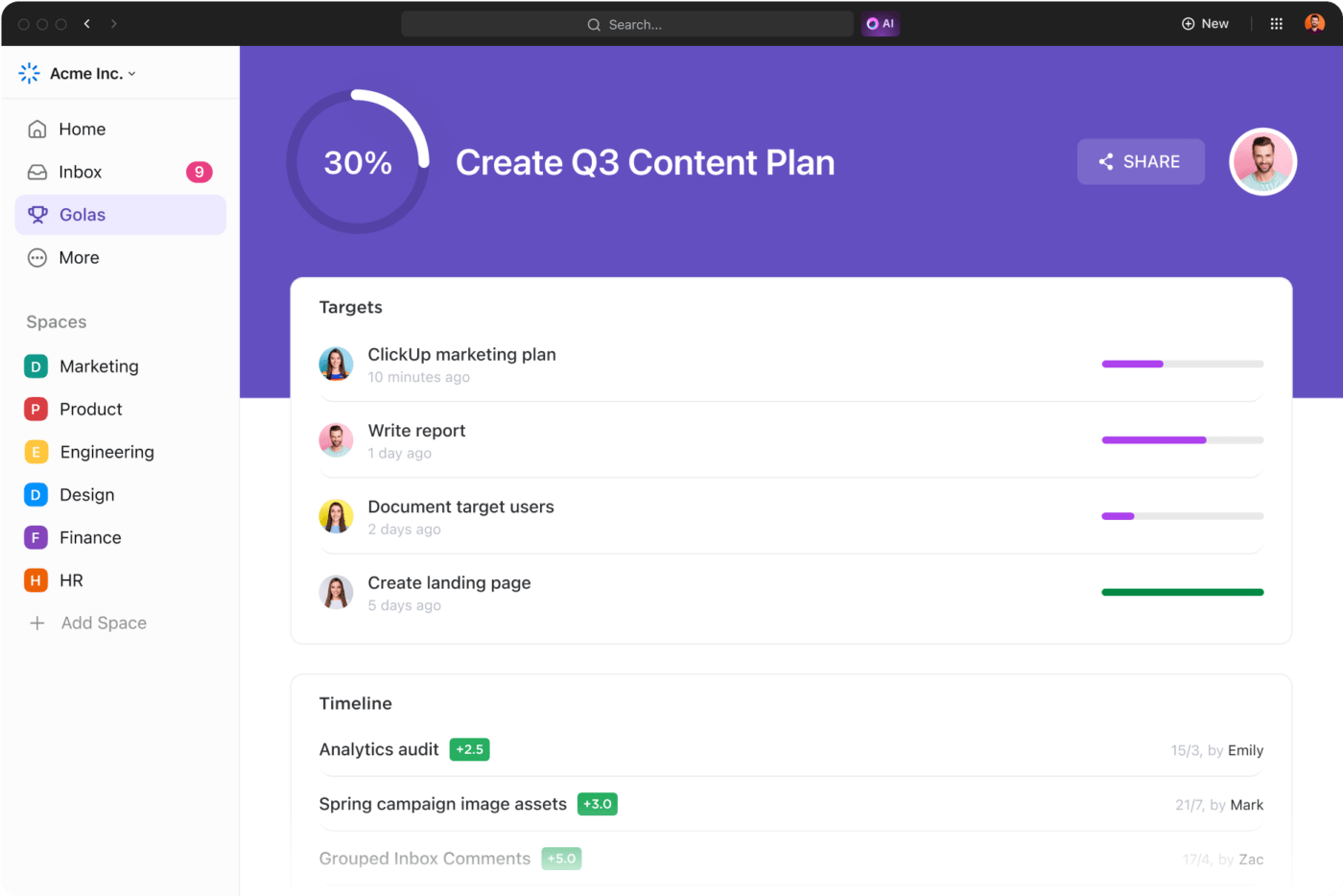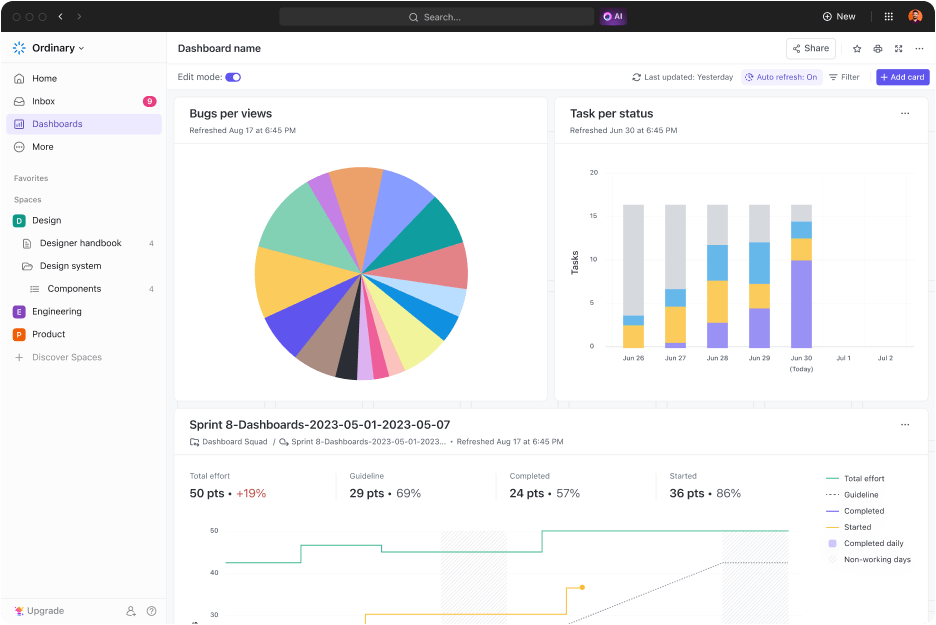How to Strategically Set and Achieve Long-Term Goals (+Examples)

Sorry, there were no results found for “”
Sorry, there were no results found for “”
Sorry, there were no results found for “”
Have you ever wondered how great leaders craft their legacies? It all starts with visioning beyond the here and now.
Now, let’s switch gears, and think about your professional journey—say 10 years from today. Imagine yourself breaking sales records, introducing a product that changes the market, or building the best customer support team the industry has ever seen.
But turning these aspirations into reality comes with its challenges.
According to a study, only 8% of people achieve their New Year’s goals, which often include long-term objectives.
While creating long-term goals is relatively easy, turning them into a reality might be where a lot of us get stuck.
Let’s explore how you can effectively create, track, and achieve your long-term goals. We will also look at a bunch of examples of long-term goals, setting the stage for your personal and professional triumph.
Long-term goals are strategic, actionable plans that turn aspirations into achievable objectives. They are carefully planned (and reflected on) and usually extend over several years or even decades.
These goals require ongoing commitment and strategic planning. Sometimes, short-term goals act as milestones to these ambitious goals, which feed into professional and personal goals.
Whether that’s retiring early, becoming a C-level executive, or expanding your business internationally, long-term goals will help you set the framework for sustained effort and lasting success.
First, let’s understand the difference between different types of goals.
Long-term professional goals require sustained effort over the years, while short-term goals are the stepping stones that lead you toward those major achievements.
Let’s look at the difference between short-term goals vs. long-term goals in brief:
| Aspect | Long-term goals | Short-term goals |
|---|---|---|
| Time frame | Several years to decades. Usually more than 3 years | Days to months. Usually less than a year |
| Example | Get a senior executive position in a global corporation | Complete a professional certification relevant to your field |
| Focus | Strategic, future-oriented | Immediate, operational |
| Purpose | Set the stage for career advancement and long-term corporate success | Provide immediate results and progress markers toward larger goals |
| Planning required | Extensive, involving career path mapping and professional development strategies | More immediate, involving tasks and short projects |
A Harvard Business study found that 14% of people who set goals are ten times more successful than those who don’t.
Setting long-term goals guides your journey toward significant milestones and aligns your daily actions with your broader life and career aspirations.
Here are five compelling reasons to set long-term goals:
Long-term goals provide a clear sense of purpose and direction. According to research, 86% of leaders believe defining a purpose is crucial for a successful growth strategy.
Establishing these goals allows you to intentionally outline your future path. In a lot of ways, long-term goals help us move forward in life, and make us hopeful for our own future.
Did you know that people who set clear long-term goals are 42% more likely to achieve them than those who don’t?
These goals help you stay motivated and committed to the process. When you have a clear goal, you’re more likely to persist through challenges and setbacks, keeping your long-term vision in sight.
Setting ambitious long-term goals often requires acquiring new skills and knowledge, which are beneficial for immediate tasks and future advancements.
Knowing your long-term objectives lets you prioritize your time, finances, and other resources. It ensures you’re investing in areas that offer the highest return.
Setting these goals allows you to build a legacy and create a lasting impact. Long-term goals often involve projects and achievements that go beyond personal goals. It contributes to your profession, community, or a cause you care about deeply.
Setting long-term goals effectively is crucial for turning your vision into reality. It involves clear planning, consistent effort, and a strategic approach that aligns with your personal and professional goals.
Let’s examine how you can set these goals effectively.
Start by envisioning where you see yourself in the future.
This vision should be inspiring and align with what you truly want to achieve. Your vision acts as the foundation for all your long-term goals.
Suppose you’re the head of a product team for a consumer electronics company. Your professional vision might be to become the CEO. For this, you might need to perform certain tasks and responsibilities.
This vision involves:
💡 Pro Tip: You can also do this creatively by using a vision board, where you can visualize your goals with photos, quotes, and more.
Once your vision is clear, break it down into specific, actionable objectives. Don’t just do it in your head or have a rough paper estimate. Make sure you’ve chalked out the mini-milestones, the half-point check, and everything else.
According to a Charles Schwab report, individuals with a written financial plan are twice as likely to progress significantly toward their long-term financial goals, like retirement.
Use proper tools to define these objectives with a clear timeline.
For instance, with ClickUp’s Goals, you can create, edit, and manage trackable goals related to your work.

Whether increasing quarterly sales by 20% or leading a major project, ClickUp helps you specify and manage these objectives effectively.
Use your values as a guiding compass to define your long-term goals. Don’t get caught in wishing for everything but end up working on nothing.
Ask yourself these questions to get you started:
Adopt the SMART goals framework to refine your objectives further.
Let’s apply the SMART goals framework to an example.
The ClickUp SMART Goals template can help you apply this framework efficiently. This template assists in setting detailed targets, organizing tasks, and monitoring progress.
With the SMART goals template, you can:
Achieving long-term goals demands actionable strategies that guide daily endeavors toward these major objectives. Here’s how you can effectively navigate through setbacks and opportunities alike:
You must see challenges as opportunities for development and persist in the face of setbacks.
In a growth mindset, people believe that their most basic abilities can be developed through dedication and hard work, while brains and talent are just the starting point.
Thus, individuals with a growth mindset are more likely to embrace learning, persist through difficulties, and ultimately reach their long-term goals, compared to folks with a fixed mindset
This mindset fosters an environment where continuous improvement is the norm and innovation thrives.
Bonus: Growth mindset is a topic researched and developed by psychologist Carol Dweck. If you are interested, read—Why Moving From a Fixed Mindset to a Growth Mindset is Harder Than You Think.
ClickUp’s Personal Development Plan Template is designed to systematically foster a growth mindset by allowing users to set, track, and achieve personal and professional goals.
This structured approach helps individuals:
Building consistent habits and routines is crucial for achieving long-term goals. Integrating structured habits into your daily life creates a foundation that continuously propels you toward your objectives.
But let’s face it: building habits and routines isn’t an easy feat. This is where you can get help from various habit-tracker templates to ease your habit-building process.
ClickUp Personal Habit Tracker Template can become your partner in building long term habits. This template is designed to help you set specific goals for habit formation and provides a comprehensive system to track and analyze your daily progress.
Whether you’re looking to establish routines in your professional or personal life, such as time management and prioritization, or personal habits like fitness and meditation, this template makes it easy to stay organized and motivated.
ClickUp’s template simplifies habit stacking by letting you:
Tracking progress is a vital component of achieving long-term productivity goals. By monitoring incremental successes and setbacks, you ensure alignment with your strategic objectives, making adjustments as necessary to stay on course.
You can use ClickUp Tasks to oversee project-related tasks and personal life management goals effectively. This dual functionality makes ClickUp an indispensable tool for ensuring that every action is a step towards your overarching plans.
ClickUp’s Project Tracker Template is also an exceptional tool for this purpose. It helps integrate seamless task management that keeps your projects and life management goals on track.
Challenges and setbacks are inevitable, but having the right tools and strategies can make all the difference in navigating these hurdles effectively.
ClickUp offers a suite of features that can help in identifying, addressing, and overcoming obstacles that may impede your progress:



Long-term goals can span various aspects of your personal and professional life, helping to guide your journey toward personal goal fulfillment.
Here are some goal-setting examples for key areas:
Whether it’s career milestones, financial stability, personal growth, or health and wellness, each goal you set is a step towards building a life of fulfillment and success.
With the right tools and approaches, such as those offered by ClickUp, you can transform these aspirations into tangible outcomes.
Ready to take control of your future and start achieving like never before?
Dive into the world of optimized goal management and enhanced productivity with ClickUp.
Don’t just dream—plan, act, and succeed. Start your journey with ClickUp today!
© 2025 ClickUp